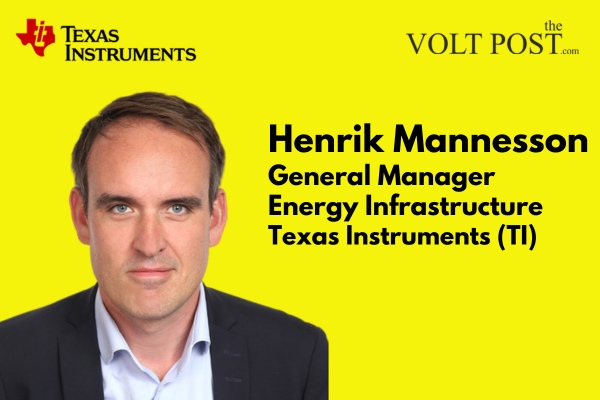 Texas Instruments (TI) is helping evolve the renewable energy landscape through advanced semiconductors for green grids automation, energy storage and electric vehicle (EV) charging. We offer a range of semiconductors designed to help customers build safe, efficient and precise ESSs such as battery packs mentions Henrik Mannesson, General Manager for Energy Infrastructure, TI. In this Volt-Full Interview with Harleen of The Volt Post, Henrik goes along stating across many pivotal facets including how TI has been creating more greener, smarter and more resilient grids, there advanced design architectures in GaN power technology. He diligently touches upon TI’s sustainable-front portfolio of analog and processing technologies and not to miss their growing focus into high-voltage technologies. All into this below edited Volt-Full Excerpts.
Texas Instruments (TI) is helping evolve the renewable energy landscape through advanced semiconductors for green grids automation, energy storage and electric vehicle (EV) charging. We offer a range of semiconductors designed to help customers build safe, efficient and precise ESSs such as battery packs mentions Henrik Mannesson, General Manager for Energy Infrastructure, TI. In this Volt-Full Interview with Harleen of The Volt Post, Henrik goes along stating across many pivotal facets including how TI has been creating more greener, smarter and more resilient grids, there advanced design architectures in GaN power technology. He diligently touches upon TI’s sustainable-front portfolio of analog and processing technologies and not to miss their growing focus into high-voltage technologies. All into this below edited Volt-Full Excerpts.
How is TI making the grid greener, smarter and more resilient?
At Texas Instruments, we are helping evolve the renewable energy landscape through advanced semiconductors for grid automation, energy storage and electric vehicle (EV) charging.
For example, our DC/DC converters and battery-management devices are designed to improve efficiency and extend battery life in energy storage systems (ESSs), while our gallium nitride (GaN) power technology can help engineers create smaller, more efficient, and faster charging solutions for EVs.
Through continuous innovation, we are enabling the next generation of a resilient, flexible and sustainable energy infrastructure.
Texas Instruments portfolio of analog and processing to help customers in their sustainability efforts.
Our extensive portfolio of analog and embedded processing technologies plays a crucial role in supporting companies’ sustainability initiatives across various industries. For example, our high-power-density and high-efficiency semiconductors enable designers to develop smaller, energy-efficient and more affordable systems.
When technologies such as solar power and smart electricity meters are more accessible, companies will be better equipped to transition to electrification.
In addition to our semiconductors, we provide user-friendly design tools, software and reference designs, and collaborate closely with third-party hardware and software companies to help our customers reduce time to market.
Texas Instruments length and breadth focus on the energy transition will be around high-voltage power conversion, current and voltage sensing, edge processing, and connectivity and battery management. There my question is, given the mammoth portfolio, how do you strategize to cater to different customer demands while innovating around the specific needs?
Our strategy revolves around a broad portfolio of semiconductors and deep expertise in semiconductor technologies designed to enable smarter, more reliable and more energy-efficient solar, ESS and EV charging systems.
We take a customer-centric approach, collaborating closely with our global network of third parties and stakeholders to understand specific industry challenges and requirements, and then working across our product lines to deliver the best design approach.
This strategic alignment allows Texas Instruments to offer comprehensive products and reference designs for high-voltage power conversion, sensing, edge AI, connectivity and battery management, empowering our customers to navigate the complexities of sustainability while driving innovation in their respective fields.
Is Texas Instruments also helping customers build a perfect ESS system – like the monitoring and measuring of cell voltages precisely?
Yes, we offer a range of semiconductors designed to help customers build safe, efficient and precise ESSs such as battery packs. Our portfolio includes devices needed to monitor, measure and control battery systems with high safety, accuracy and efficiency.
For battery monitoring and balancing, our semiconductors can accurately measure individual cell voltages, currents and temperatures, and support diagnostics and safety analysis for battery data monitoring. These devices help maximize battery capacity, protect against failures, and extend cycle life.
From a processing perspective, our functional safety-compliant embedded processors can be used to run battery-management algorithms and communicate with other systems. Low-power microcontrollers are can be used in small battery packs, while higher-performance processors enable sophisticated management of large ESS installations.
How are high-voltage technologies becoming vital to empower a more sustainable future?
High-voltage technologies such as GaN are instrumental in driving a more sustainable future by significantly enhancing power efficiency and density in various applications. These technologies enable more efficient energy-conversion processes, reducing losses during power transmission and storage.
By increasing switching frequencies and power densities, high-voltage technologies enable the development of compact and lightweight power electronics, essential for renewable energy systems such as solar inverters and EV chargers.
This technological advancement supports the widespread adoption of renewable energy sources, improves grid stability, and reduces carbon footprints, thereby accelerating the transition toward a sustainable energy ecosystem.




